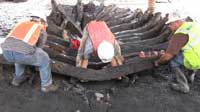
Photo: Neil Pederson, Lamont-Doherty, provided courtesy of LMDC
Last July, workers excavating at the new World Trade Center site in lower Manhattan uncovered the remains of an 18th century wooden merchant ship 20 feet below street level. See our previous posts – here and here. Now researchers have been able to identify where the ship was probably built, the trade she most likely served in, and how she met her end, all from careful examination of tree rings, ship worms and other artifacts found on the ship. A fascinating investigation.
Rings and Worms Tell the Tale of a Shipwreck Found at Ground Zero”
This shipwreck gives us a glimpse of the past—the last chapter in a complex story. We can start rebuilding and rewriting those other chapters of a ship’s life by doing things like dendrochronology,” says tree-ring specialist Pearce Paul Creasman of the University of Arizona, in Tucson.
Over the next several months, a range of experts would start nailing down some important clues. Most recent are the newly released conclusions from the Columbia team’s tree-ring analysis. In their report Pederson and his colleagues suggest that the ship was likely built in 1773 in a small shipyard on the outskirts of a major metropolitan center.
A maritime historian and a plant pathologist, among others, analyzed data ranging from horseshoe crabs to shipworms to help corroborate these findings and fill in other blanks.
Thanks to Irwin Bryan for passing the article along.
